General guidance on handling loads
Contents
A copy of this leaflet can be down loaded as a Microsoft Word 97 document - Here
Manual handling at work is the cause of 36% of all accidents reported every year to the Health and Safety Executive. Injuries resulting from a manual handling accident may be a hernia, cut or a bruise, but more commonly it is a strain ( a wrench or tear of muscle) or a sprain (a wrench or tear of ligament) to a limb or the back.
Since any employee within a variety of workplaces (e.g. workshops, laboratories, residences, catering and grounds) may at sometime need to move a heavy or awkward load, the following guidance is given on the best way to avoid injury.
NOTE: No member of staff should attempt to lift or move a load if they are in any doubts as to their capability to do so without risk to their health and safety.
There is a risk of back injury if, during tasks that you routinely carry out, there is frequent or prolonged:
If you think that routine manual handling carried out during the course of your work may put you at risk, contact your School/Unit Safety Co-ordinator.
Guidance on Moving Heavy and/or Awkward Loads
Clothing
Generally shoes should be flat with non-slip soles, clothes should be loose enough for free movement, but tight enough to avoid snags. If the object has sharp or rough edges, or the object may be at an extreme temperature then you should wear the appropriate type of personal protective equipment.
Lifting Heavy and/or Awkward Loads
1.
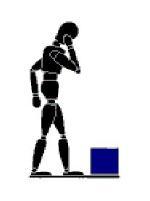
Stop and Think
Plan the lift. Where is the load going to be placed? Use appropriate handling aids if possible. Do you need help with the load ? Remove obstructions such as discarded wrapping materials. If you are carrying the load over a distance, you should ensure the route is clear of any obstacles or blockages before you begin the lift. For a long lift - such as floor to shoulder height - consider resting the load mid-way on a table or bench to change grip.
2.

Place the Feet.
Have the feet apart, giving a balanced and stable base for lifting (tight skirts and unsuitable footwear make this difficult). Have the leading leg as far forward as is comfortable.
3.
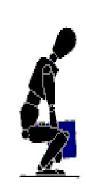
Adopt a Good Posture.
Bend the knees so that the hands when grasping the load are as nearly level with the waist as possible. Do not kneel or over flex the knees. Keep the back straight, maintaining its natural curve (tucking in the chin while gripping the load helps). Lean forward a little over the load if necessary to get a good grip. Keep the shoulders level and facing in the same direction as the hips.
4.
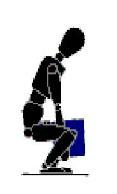
Get a Firm Grip.
Try to keep the arms within the boundary formed by the legs. The optimum position and nature of the grip depends on the circumstances and individual preference, but it should be secure. A hook grip is less fatiguing than keeping the fingers straight. If it is necessary to vary the grip as the lift proceeds, do this as smoothly as possible.
5.

Lift Load Smoothly.
Carry out the lifting motion smoothly, raising the chin as the lift begins, keeping control of the load.
6.
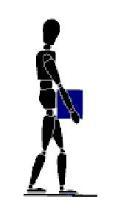
Move the Feet.
Do not twist the trunk when turning to the side.
Keep Close to Load
Keep the load close to the trunk for as long as possible. Keep the heaviest side of the load next to the trunk. If a close approach to the load is not possible, try sliding it towards you before attempting to lift it.
7.
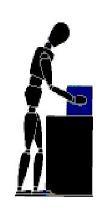
Put Down, then adjust.
If precise positioning of the load is necessary, put it down first, then slide it into the desired position.
It is recommended that if the handler is lifting a load to shoulder height or above, then, if practicable, an intermediate resting place for the load should be used to allow the handler to change hand grip.
Note: Items should not be stored above head height unless there is a suitable means of access. Items should never be stacked on shelving above head height.
EMERGENCY
----------------------------------------------------------------------------------------
External Telephone Line or Public Telephone (Anytime): 9-999
----------------------------------------------------------------------------------------
Fire
1. Operate Fire Alarm. If none, shout 'FIRE !'
2. Call the Fire Brigade. Telephone 9-999
State precise location of fire. Give your name and telephone number. Wait for confirmation of message.
Medical
If a medical emergency seems to be outwith the capability of a First-Aider, take the following actions:-
1. Transport casualty directly to St-Andrews Memorial Hospital
OR
2. Call an ambulance: Telephone 9-999
----------------------------------------------------------------------------------------
Issued by Environmental, Health and Safety Services October 2001
----------------------------------------------------------------------------------------
